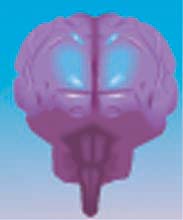Two Hemispheres Better Than One
For Aging Brains

Older adults actually use different regions of the brain compared to younger adults to perform the same memory and information processing tasks. Cognitive neuroscientist Patricia Reuter-Lorenz and colleagues provide intriguing clues about how older adults compensate for some of the age-related declines in short-term memory and mental speed that plague so many older Americans.
"Older adults activate both hemispheres of the brain to remember what younger adults can remember using just one hemisphere," says Reuter-Lorenz.
Reuter-Lorenz and colleagues used functional positron emission tomography (PET) images to elucidate how the aging brain works. Not only have they found that as we age, two hemispheres are better than one, they have also discovered that in older adults, unexpected regions of the brain are activated for verbal and spatial memory tasks.
When younger adults hold information in short-term memory, like rehearsing a phone number, they activate a network of brain regions involved in speech and short-term verbal storage. Older adults activate these areas also, but show additional activation of a frontal cortex region that young adults use only when performing complex short-term memory tasks.
In one study, older and younger subjects were shown four letters, then asked to determine if a letter presented a few seconds later matched any of the initial four. As expected, Reuter-Lorenz found that seniors made more errors and were slower at the task than young subjects. And PET scans of the subjects' brains while they were being tested showed that older subjects activated more areas of the brain in both hemispheres than young subjects, who showed activity mainly in the left hemisphere.
In another study of spatial memory, subjects were shown a group of marked locations on a screen, then presented a few seconds later with a single mark and asked to determine whether its position matched any in the earlier group. Reuter-Lorenz again found different activation patterns for younger and older subjects. Younger subjects showed greater right hemisphere activation, while older subjects activated both left and right hemispheres.
"Recruiting additional regions of the brain seems to assist older adults in basic memory storage tasks," Reuter-Lorenz says. "But when it comes to more complex processing tasks, this strategy isn't as successful."
When seniors and young subjects were asked to determine the accuracy of a math calculation ((10x9) + 8 = 98), their performance was equivalent. But when subjects were presented with a word in addition to the math problem, and asked to remember it, the performance of seniors dropped dramatically.
Because regions at the front of the brain, in the area known as the dorsolateral prefrontal cortex (DLPFC), were "recruited" by the seniors for the simple short-term memory task, Reuter-Lorenz believes that these regions may have been preoccupied and less available for the more complex tasks.
Overall, though, Reuter-Lorenz believes that older adults benefit from bi-hemispheric processing. Using two hemispheres instead of one, and more of the brain overall, may allow seniors to compensate for some of the mental declines that come with age, she suggests. Moreover, by identifying precisely which areas of the brain seniors are using to remember and process information, she hopes that scientists and physicians will be able to develop more effective interventions to help seniors maintain and improve brain function well into old age.
|
Keep your brain fit and healthy with Compublox, a series of mental exercises, designed to improve a variety of cognitive skills including concentration, processing speed, memory, and logical thinking.
|
|